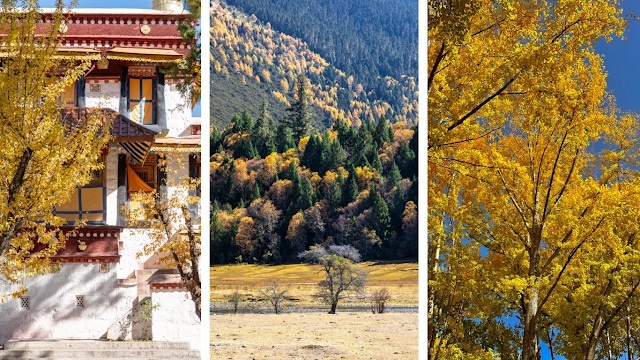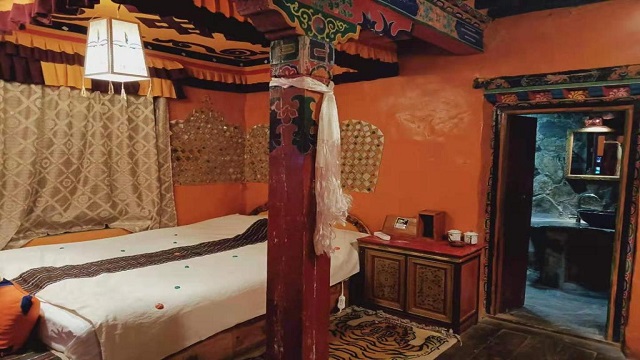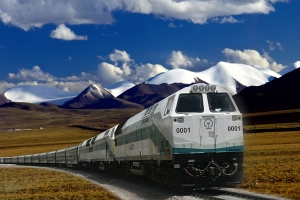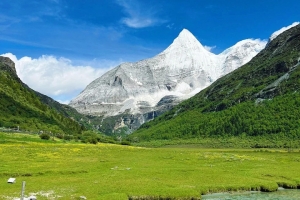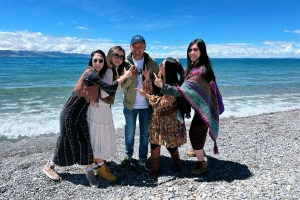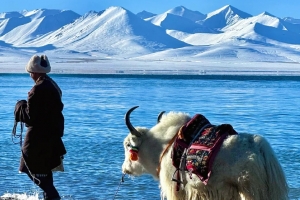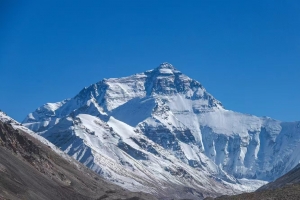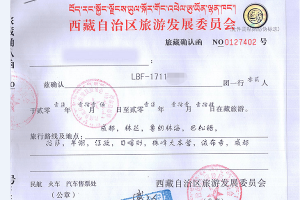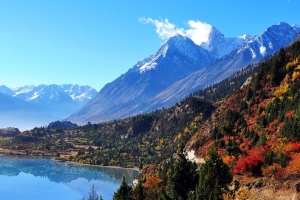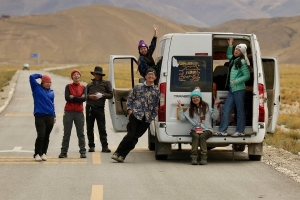Tibet in autumn is nothing short of magical. As summer’s monsoon retreats, the high plateau is bathed in crisp, clear blue skies and golden afternoon light. From September through November, you’ll find stable weather, vibrant fall foliage, and far fewer crowds than in peak summer months. It’s widely regarded as the best time to visit Tibet: the landscapes burst into reds and golds, mountain peaks and turquoise lakes sit crystal-clear against the skyline, and cool nights follow comfortably warm days. If you’re planning Tibet autumn travel, read on for the ultimate guide covering weather, what to wear, must-see sights, cultural experiences, wildlife viewing, photography tips, logistics, and a strong call to action to start booking your trip now.

Why Autumn Is the Best Time to Visit Tibet
- Unbeatable Clarity
After the rainy season ends in late August, Tibet’s air becomes remarkably pure. Clouds thin out, dust settles, and visibility often exceeds 30 kilometers. Whether you’re gazing at the jagged peaks of the Himalayas or peering down into the deep Yarlung Tsangpo Gorge, the skies remain an intense, uninterrupted blue. - Spectacular Fall Colors
- September brings the first hints of gold and red to forests in eastern Tibet, especially around Nyingchi and Linzhi.
- October turns grasslands and hillsides into seas of amber and rust, creating striking contrasts with snow-topped summits.
- November adds a dusting of snow to high passes, merging autumn’s warm tones with the first whispers of winter white.
- Fewer Tourists
Compared to July and August, traveler numbers drop by around 30% in autumn. You’ll have Potala Palace, Jokhang Temple, and Namtso Lake all to yourself early in the morning, making for unforgettable, photo-friendly moments without the summer crowds. - Rich Cultural Festivities
Autumn hosts several unique Tibetan festivals, including Lhabab Duchen (the Buddha’s Descent Day), the mesmerizing Barefoot Pilgrimage, and local harvest celebrations. These events offer deep insight into Tibetan religion and rural life, adding a cultural layer to your trip.
Tibet Weather September – November & What to Wear
| Month | Daytime Temp | Nighttime Temp | Clothing Tips |
|---|---|---|---|
| September | 10–20 °C (50–68 °F) | 0–10 °C (32–50 °F) | Light layers: T-shirt, thin fleece, windbreaker; base layer, hiking pants, sunhat |
| October | 5–15 °C (41–59 °F) | –5–5 °C (23–41 °F) | Medium layers: long-sleeve shirt, fleece or light down, gloves; thermal underwear optional |
| November | 0–10 °C (32–50 °F) | –10–0 °C (14–32 °F) | Heavy layers: down parka, warm pants, wool hat, scarf; insulated boots |
- Layering Is Key
Mornings and evenings can be frosty even if afternoons feel mild. Pack moisture-wicking base layers, a mid-layer fleece or down vest, plus a wind- and water-resistant outer shell. - Sun Protection
High-altitude UV is fierce year-round. Bring SPF 50+ sunscreen, UV-blocking sunglasses, and a broad-brimmed hat. - Footwear & Accessories
Sturdy hiking boots with good ankle support are a must. Include wool socks, a warm hat, gloves, and a neck gaiter or scarf to block wind.
Top Autumn Attractions in Tibet
Lhasa: Potala Palace & Jokhang Temple
- Why Go in Fall: Clear skies highlight the palace’s white and red walls; golden trees line the Barkhor market.
- Insider Tip: Arrive at Potala Palace just before sunrise to capture the palace aglow in morning light, then wander to Jokhang Temple for midday prayers and butter lamp ceremonies.
Namtso Lake
- Fall Magic: Mirror-like reflections under vibrant blue skies; snow-rimmed peaks frame the shoreline.
- Camping: Pitch a tent on the lakeshore to sleep under a star-studded sky—the air is dry, so nights are cold but clear.
Mount Everest Base Camp (EBC)
- Best Season: October offers minimal clouds and prime visibility for Everest’s south face.
- Travel Style: Drive to Tingri or hike from Shigatse; many opt for a teahouse trek with guides to acclimatize gently.
Mount Kailash & Lake Manasarovar
- Sacred Pilgrimage: The 52 km kora around Kailash is a defining spiritual journey; fall’s calm weather makes the trek more comfortable.
- Highlight: Sunrise view of Kailash reflecting in Lake Manasarovar’s turquoise waters is nothing short of transcendent.
Yamdrok & Other Sacred Lakes
- Scenic Drives: The Lhasa–Gyantse road passes Yamdrok Lake, with poplar groves turning gold in autumn.
- Photo Ops: Pull over at viewpoints to capture the lake’s vivid color against barren hills.
Shigatse & Tashilhunpo Monastery
- Harvest Vibes: Fields around Shigatse turn golden in September, with farmers harvesting barley and buckwheat.
- Cultural Scene: Tashilhunpo’s autumn festivals include horse races and local markets.
Nyingchi’s Eastern Woods
- Tibet’s Switzerland: Rivers, cedar forests, and waterfalls set among autumn foliage.
- Must-Sees: Basumtso Lake, Ranwu Lake, and the Great Bend of the Yarlung Tsangpo.
Yarlung Zangbo Grand Canyon
- Epic Scale: One of the world’s deepest gorges in full fall color.
- Adventure: Boat trips or scenic flights reveal dramatic cliffs and golden slopes.
Tibetan Culture & Autumn Festivals
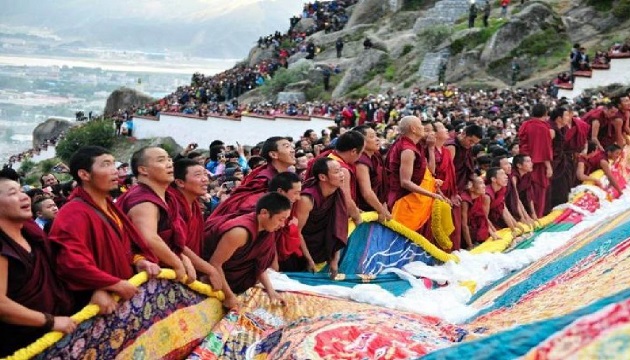
- Lhabab Duchen (Buddha’s Descent Day): Celebrated in October or November, this day marks Buddha’s return to Earth. Monks light butter lamps and devotees perform prostrations around Jokhang Temple.
- Ganden Ngachö (Je Tsongkhapa Day): In autumn, Gelug monasteries honor their founder with massive butter-lamp offerings and special pujas.
- Traditional Harvest Celebrations: In rural areas, farmers host impromptu gatherings with tsampa (barley flour) dancing and butter-tea feasts to mark crop collection.
- Prayer Flag Rituals: Fall’s clear, windy days are perfect for hanging new prayer flags on mountain passes, ensuring mantras fly freely in the breeze.
Participating or simply observing these local celebrations offers deep insight into Tibet’s living traditions.
Wildlife & Natural Wonders in Autumn Tibet
Autumn’s thinning crowds and clear weather make wildlife spotting and nature treks extra rewarding:
- Tibetan Antelope (Chiru) & Wild Yak: Wander the Changthang grasslands for large herds grazing against amber plains.
- Kiang (Tibetan Wild Ass) & Blue Sheep: Look in higher valleys for these agile graziers.
- Birdwatching: Alpine lakes draw bar-headed geese, black-necked cranes, and lammergeiers. Forested eastern regions host redstarts and Himalayan monals.
- Hot Springs: Warm up in Yangpachen’s steaming pools beside frozen lakes—an incredible contrast of hot and cold.
- Glaciers & Waterfalls: Rivers still flow before winter freeze-over; seek out Yarlung Tsangpo cascades and Nyingchi’s forest falls.
Autumn in Tibet is a true celebration of rugged, pristine ecosystems.
Photography & Travel Tips in Autumn Tibet
- Gear Essentials: A wide-angle lens for landscapes and a zoom lens for wildlife, plus extra batteries (cold drains power fast) and plenty of memory cards.
- Protect Equipment: Use lens hoods to guard against wind-blown dust, and carry microfiber cloths for lens cleaning.
- Respect Customs: Always ask before photographing monks, pilgrims, or religious sites, and follow monastery rules on cameras and silence.
- Health & Safety: Stay hydrated, pace yourself to counter altitude sickness, and consider bringing Diamox or portable oxygen.
- Backup Plans: Download offline maps, carry a power bank, and keep paper copies of permits and reservations—connectivity can be spotty.
Transportation & Accommodation in Autumn Tibet
- Tibet Travel Permit: Non-Chinese travelers must join a guided tour or hire a licensed guide/driver to obtain the mandatory Tibet Travel Permit.
- Getting There: Fly into Lhasa’s Gonggar Airport from major Chinese cities, or take the Qinghai–Tibet Railway for a scenic overland entry.
- Moving Around: Private vehicles are the norm; sleeper buses run between cities for budget travelers. Domestic flights connect Lhasa, Shigatse, Nyingchi, and Ngari.
- Road Conditions: Autumn roads are generally in excellent shape after monsoon rains end. Carry sea-sickness medicine if you’re prone to motion sickness on mountain passes.
- Where to Stay: Lhasa offers guesthouses to 5-star hotels. At Everest Base Camp, teahouse accommodations are basic but cozy; in remote areas, expect simple inns or camping under the stars.
- Budget Tips: After mid-October prices often dip since it becomes low season, so you can score discounts on tours and rooms.
Book Your Tibet Autumn Adventure Today
Autumn’s crisp air, clear skies, and kaleidoscope of golden landscapes make September through November the ideal window for Tibet travel. Whether you’re chasing sunrise over Potala Palace, photographing the mirror-like serenity of Namtso Lake, trekking to Everest Base Camp, or joining colorful local festivals, Tibet in fall delivers on every front. The best time to visit Tibet is now – pack your layers, sort your permits early, and prepare for an unforgettable journey to the “Roof of the World.” Your dream Tibet autumn adventure awaits.

